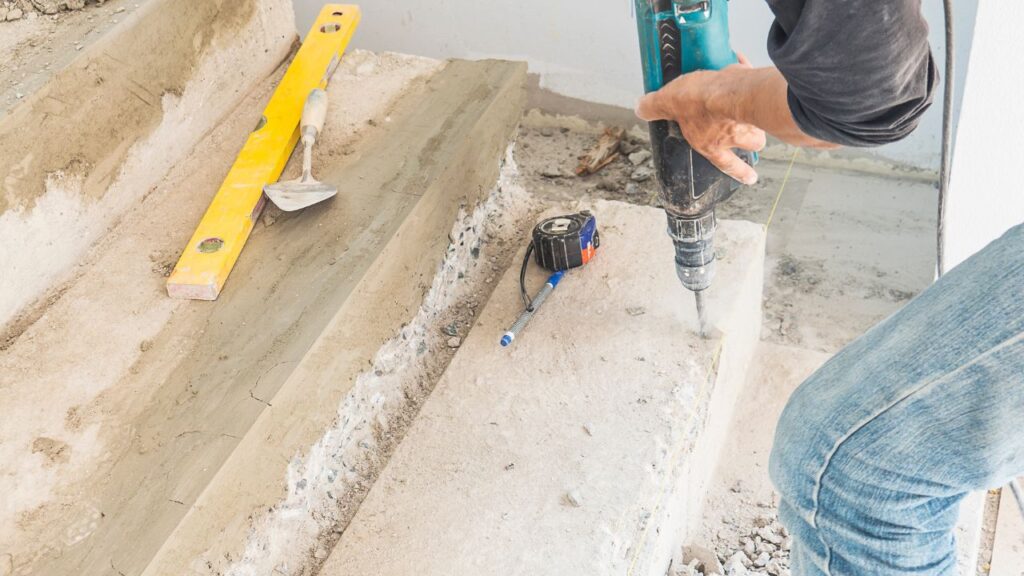How To Repair Concrete Steps?
Inspect the damage
Assess and analyze any visible damages on the steps. Check for cracks, wear and tear, crumbling and chipping. Make a note of the extent of the damage to ensure proper restoration.
To make sure that the repair is successful, consider things like the cause of damage, safety concerns and the durability of the work. Investigate if the damage was caused by moisture, freezing/thawing cycles or a sub-standard concrete mix.
Clean the surface before repairing, to increase adhesion when applying components or filling agents. Trisodium phosphate and pressure washing equipment are safe to use on concrete surfaces.

Pro Tip: Before fixing the steps, make sure there’s a clear path for movement to avoid slipping injuries. Now, get ready to repair those steps with your hammer, chisel and concrete mix!
Gather necessary tools and materials
Get ready to repair those steps! Wear protective gear like gloves, goggles, and a dust mask. Next, grab the tools you need, like a hammer, mason’s trowel, chisel, and wire brush. Don’t forget to gather materials like concrete mix, bonding agent, and water. Plus, have a source of clean water and a container for mixing. Different repairs may also require specific tools and materials. According to The Concrete Network, “Concrete is the most widely used material in the world.” So, it’s time to give those steps a makeover! Cracked concrete isn’t a fashion trend.
Prepare the damaged area
To prepare the damaged area of your concrete steps for repair, you need to clean the surface, remove loose corners and edges, and create a rough surface for the new concrete to adhere to. These sub-sections will facilitate the repair process and ensure that the repaired area blends seamlessly with the existing concrete.
Clean the surface
To begin the repair process, it is key to make sure the surface is clean. Leaving dirt or debris on the surface can impede the repair process and produce unsatisfactory results.
For the best clean:
- First, use a wire brush or sandpaper to remove any paint, rust, or other debris from the damaged area.
- Next, wash the surface with soap and water. Rinse with clean water and let it dry completely.
- Finally, use mineral spirits to remove grease or oil. Make sure the area is well-ventilated and follow safety guidelines.

Do not use abrasives as they may damage the surface more. One may also consider masking off adjacent areas to protect them from scratches.
A good clean ensures better bonding with patching compounds or adhesives. Poor adhesion will result in weak patches that will not last long.
Follow these steps carefully for the ideal preparation of damaged areas before any repairs. Don’t disrupt your repair work later by not taking this crucial step seriously! Trim loose corners and edges for a better overall health and appearance.
Remove loose corners and edges
It is key to prepare the damaged area by eliminating any loose or vulnerable corners and edges. To do this, carefully remove any unattached sections. Here is a 5-step guide:
- Look at the damage.
- See which areas need help.
- Scrape off peeling or loose bits.
- Smooth the scraped area with sanding.
- Clean the area, removing dust.
Note: Failing to get rid of all weakened parts can lead to an unsuccessful repair job or extra repairs. This preparation step is the groundwork for successful restoration. Neglecting it may result in bigger problems later.
The National Institute of Health states that wet soil conditions caused by rain can lead to undetected water damage and weak foundations. Remember, rough surfaces make tough foundations. Just like a breakup leads to a glow up!
Create a rough surface for the concrete to adhere to
To make sure the concrete sticks, you must make the damaged area rough. This creates a strong connection between the existing surface and the concrete on top, making it hold better. Here are four steps for creating a rough surface for concrete adhesion:
- Clean the spot. Get rid of any debris or loose material. Use a pressure washer or stiff-bristled brush.
- Score or etch the surface with a chisel or wire brush. This exposes fresh concrete and makes a textured surface for better adhesion.
- If needed, use a bonding agent as per instructions. This gives extra grip.
- Let the area dry completely before pouring new concrete.
Not making the surface rough can lead to cracking and delamination. Also, following these steps strengthens the repair’s overall structure. So, take all steps seriously when preparing the damaged area. If you skip any, it could affect the quality and life of the repair. Don’t risk further damage – follow the steps for the best results! Preparing concrete is like making a cake. But instead of flour and sugar, you use aggregate and cement, and instead of a sweet treat, you get a solid base for your home.
Prepare the concrete mixture
To prepare the concrete mixture for repairing concrete steps, mix the concrete by following the sub-sections – add water and stir until the desired consistency is reached. This section of the article on “How to Repair Concrete Steps” with a focus on preparing the concrete mixture will guide you through the necessary steps to ensure your concrete repair project is a success.
Mix the concrete
Mixing concrete is an important part of construction. It can be tricky, but it is not impossible. Here’s a step-by-step guide for mixing concrete:
- Gather cement, sand, water and aggregates.
- Mix each component in the right ratio.
- Add sand and aggregate to a mixer. Blend the cement on top.
- Slowly add water and mix until you have a firm, moldable consistency.
- Pour or move the mixture onto your work surface quickly.
Remember, don’t use too much of any material. Otherwise, problems may arise. Mix like a pro for a feeling of accomplishment. Preparing concrete right improves its durability and strength, so why wait?

Life isn’t as simple as adding water and stirring – it’s more like a never-ending experiment.
Mix the concrete
Mixing concrete is an important part of construction. It can be tricky, but it is not impossible. Here’s a step-by-step guide for mixing concrete:
- Gather cement, sand, water and aggregates.
- Mix each component in the right ratio.
- Add sand and aggregate to a mixer. Blend the cement on top.
- Slowly add water and mix until you have a firm, moldable consistency.
- Pour or move the mixture onto your work surface quickly.
Remember, don’t use too much of any material. Otherwise, problems may arise. Mix like a pro for a feeling of accomplishment. Preparing concrete right improves its durability and strength, so why wait?
Life isn’t as simple as adding water and stirring – it’s more like a never-ending experiment.
Add water and stir until the desired consistency is reached
To get the perfect consistency, it’s essential to add water and stir the concrete mix. This helps make a strong and durable result. Follow these 3 steps for ideal outcomes:
- Gradually pour water until moistened.
- Stir until all the dry mix has dissolved.
- Continue adding small amounts of water and mixing until you get the desired consistency.
You’re now one step closer to an awesome concrete mixture for different uses. Remember, too much water weakens the strength of the concrete. So add it gradually and keep track of how much you use.
Conduct a slump test to check if the consistency is just right. Make a cone shape from the mix on a flat surface and observe how it behaves.
Engineering For Change states that with proper maintenance, concrete structures can last up to 100 years. So get ready to make your concrete mixture into a masterpiece!
Apply the concrete mixture
To apply the concrete mixture in repairing concrete steps, with sub-sections of beginning from the outer edges and smoothing and leveling the surface are the solutions. These techniques will help ensure a strong and smooth finish, providing safety and aesthetic benefits for your concrete steps.
Begin applying concrete from the outer edges
Start from the outer edges for evenness and stability in the concrete’s structure. This will spread the mixture uniformly, leading to better leveling. Here’s a 5-Step guide to apply concrete professionally from the edges:
- Put sufficient concrete on one corner near the edge.
- Spread it evenly with a wooden float or trowel, going slowly.
- Add more mixture while spreading it toward the edge.
- Tap down with a trowel or screed board if needed, to maintain consistent thickness & evenness.
- Repeat until all areas are covered with a thin layer of concrete mixture.
For humidity control, cover newly applied surfaces with plastic sheets to prevent cracks. Also, use steady movement & sweeping motion while applying to reduce air pockets that may weaken the structure. Get ready for the smoothest surface ever!

Smooth and level the surface
Achieving a smooth, even surface requires the right application of concrete mixture. Here’s how:
- Spread the concrete evenly with a trowel or float.
- Use a screeding tool to make sure the surface is level, with no bumps or lumps.
- Smooth out imperfections with a steel trowel, back and forth.
- Brush the surface with a fine, finishing broom to create a non-slip texture for safety.
Weather conditions can affect workability. Add plasticizers and retarders to adjust water content for optimal consistency.
Skipping out on leveling can cause long-term damage to structures. Follow these steps for sturdy results. And, patience is key. Waiting for concrete to dry takes time.
Allow concrete to dry and cure
To allow the concrete to dry and cure properly after repairing your concrete steps, covering the repair with plastic is one solution. Another option is to let the concrete cure for at least 24 hours. These sub-sections will provide you with ways to ensure that your concrete steps are robust and long-lasting.
Cover the repair with plastic
To secure your concrete repair, cover it with a suitable material. This will block moisture from leaving and allow the concrete to harden properly. Here’s what to do:
- Wait until partially dry.
- Smooth out any bumps.
- Cover the repair with plastic. Make sure there are no wrinkles or gaps.
- Secure the edges with something heavy.
Be aware that unvented plastic can make sweat and weaken the repair. Use vented plastic to regulate moisture levels. Covering also keeps debris away from the fresh repair.
My client skipped the curing process and removed the covering too early. His repairs were chipped and weak due to lack of hardening. Don’t make the same mistake – wait 24 hours and make sure the repair is fully hardened before uncovering it!
Allow the concrete to cure for at least 24 hours
After you pour concrete, it’s vital to let it cure correctly before any other work is done. This will help guarantee the durability and strength of the structure.
To make sure the concrete cures for at least 24 hours, here’s what to do:
- Right after pouring, cover the concrete with plastic or a tarp to keep the moisture in.
- Keep the area around the concrete wet with a fine mist. This stops the moisture from leaving too quickly.
- Don’t put any weight on the concrete and make sure no one steps on it until it’s fully cured.
It’s important to remember that temperature and humidity can modify the curing time. Be sure to keep an eye on these conditions and adjust as necessary.

Also, for the best results, the proper curing should continue beyond 24 hours. Depending on the thickness of the concrete, it could take up to 28 days or more to cure completely.
Did you know that the Ancient Romans used a mix of volcanic ash and lime to make their own form of cement? Called pozzolanic cement, this combination was essential in building some of Rome’s well-known structures like The Colosseum.
Remember, the goal isn’t just to reach the end of the project, it’s to have a beautiful finished concrete product.
Finishing touches
To achieve a polished look for your repaired concrete steps, implement these finishing touches with sanding and application of sealant. Sanding helps smoothen any rough edges, while sealing offers protection against future damage.
Sand and smooth any rough edges
For a perfect project outcome, you need to smooth out any rough edges. Use sandpaper to get rid of sharp and jagged edges and achieve a clean, even surface. Here’s a 3-step guide for sanding:
- Pick the right sandpaper – lower grit numbers are more abrasive, while higher ones are smoother.
- Sand lightly in a back-and-forth motion, keeping the sandpaper flat. Don’t press too hard to prevent uneven surfaces or damage.
- Afterwards, wipe away dust with a damp cloth. Let it dry before starting the next step.
Take your time and wear protective gear if necessary. Before sanding, apply wood filler or putty on bigger holes or gaps to save time. Seal that deal and make your repair last longer than most celebrity marriages!
Apply a sealant to protect the repair
Protecting the repair is a must after completion. Sealants guard against moisture and other elements which can harm the repair, ensuring it lasts.
Here’s how you do it:
- Clean the area.
- Spread a thin layer of sealant over the repair.
- Brush or roll it on evenly.
- Let it dry before using the surface.
It’s essential to pick the correct sealant for each fix, based on the material you need to guard. Also, for high-traffic spots like countertops and floors, this helps avoid constant wear and tear.
If you use too much sealant, you could get an uneven surface or mess up adhesion if you need to repair again. Follow the manufacturer’s instructions for the right amount and drying times.
A customer once brought a wooden deck they had stained but forgot to seal. It was exposed to rain, which caused damage. After repairing, we applied a waterproof sealant, saving the deck from further damage.
Final inspection time – hope all the blunders are invisible!
Final inspection
To ensure that your concrete steps are reliable and sturdy, a thorough final inspection with specific checks is essential. Check for any cracks or imperfections that may have been missed in previous inspections. Make necessary touch-ups to ensure that your repaired concrete steps look as good as they function.
Check for any cracks or imperfections
Scrutinize possible harm and blemishes. To guarantee a top-notch result, look for any faults or inconsistencies. This significant step aids in providing a correct and safe final product that satisfies the customer’s expectations.
Instructions to Review Faults and Imperfections:
- Begin by turning on the lights in your workspace.
- Examine each part of the product carefully for any indication of irregularities.
- Decide if any extra modifications are essential to forestall future damage.
- Use a magnifying tool if needed, especially if you need to inspect small pieces closely.
- Prepare a report of any issues found and converse the following stage with senior-level administration immediately.
Furthermore, make sure that all company policies comply with industry rules when tackling these defects methodically.
A fundamental aspect of quality control is analyzing commodities for defects or fractures at the start of production, preventing general delays when developing a dependable item throughout all business activities.
Fun Fact: According to Quality Digest, “about 10-15% of new merchandise has blemishes.”
Cuz when it comes to modifications, it’s better to be cautious than sorry – except if you’re a surgeon, then you better be sure.
Make necessary touch-ups
As the inspection approaches, adjustments must be made to achieve a polished result. Carry out any necessary touch-ups with precision and care. High-quality materials and techniques are essential for a flawless finish.
This means attending to any visible flaws. Fixing mistakes and ensuring all elements are aligned and cohesive. Smoothing rough edges or adding finishing touches – all details must be analyzed. These steps will reduce potential errors during inspection.
Every detail counts when creating a professional impression. So, patience, precision and meticulousness are key. Avoid delays to optimize productivity and costs.
This is the moment your efforts come together! Ensure every element meets standards – failure risks negative outcomes upon review. Make the necessary touch-ups with passion and commitment for the best outcome!
Frequently Asked Questions (FAQs)
To repair concrete steps, you will need a concrete patching compound, a trowel, a wire brush, a chisel, and safety equipment such as goggles, gloves, and a dust mask.
First, clean the concrete steps thoroughly by scrubbing them with a wire brush and using a high-pressure washer to remove any loose particles. Then, chisel away any damaged or loose concrete until the surface is smooth and level.
Deep cracks in concrete steps can be repaired with an epoxy injection system. However, if the cracks are too wide or the steps are severely damaged, you may need to replace them entirely.
Read the instructions carefully and mix the patching compound according to the manufacturer’s directions. Generally, you will need to add water and mix the compound until it reaches a smooth, spreadable consistency.
Apply the compound with a trowel, pressing it firmly into the cracks and smoothing out the surface. Make sure the patching compound is level with the surrounding concrete surface.
Drying time can vary depending on the temperature and humidity. Generally, the patching compound will be dry enough to walk on after 24-48 hours. Allow it to cure completely before exposing it to heavy foot traffic or weight.
